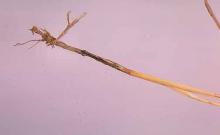See:
Wheat (Triticum aestivum) - Eyespot (Strawbreaker Foot Rot)
Fungicide Effectiveness as Seed Treatments for Cereal Diseases
Cause The fungus, Cochliobolus sativus, (syn: Bipolaris sorokiniana) that lives in soil, old stubble, and root debris and can infect most small grains and numerous grasses. Infections may be at any stage of plant growth. Plants stressed by drought or freezing are predisposed to the disease, which occurs throughout the Pacific Northwest. It is less common than Fusarium Root, Crown, and Foot Rot (Crown Rot, Foot Rot, Seedling Blight, Dryland Foot Rot) but often occurs with it.
Symptoms In late fall and early spring, brown spots or blotches appear on roots and the subcrown internode, crown, and lower leaf sheath. There are also chocolate-brown leaf spots especially on lower leaves. In humid or irrigated areas, the pathogen also may infect heads to cause black point on seed. Severe infections cause a dry crown rot that leads to premature ripening of heads (whiteheads). Symptoms are similar to those of Fusarium foot rot.
Cultural control
- Plant in late fall or early spring when soil at seed depth is 55°F or lower.
- In warmer soil, plant seed shallow and not in deep furrows or a dust mulch.
- Rotate to crops other than wheat or barley 2 or more years.
- Bury residue deeply with a moldboard plow.
- Avoid excessive nitrogen.
Chemical control Treat seed with fungicide to control common root, crown, and foot rot only. Not effective for Fusarium foot rot or for the complex known as dryland foot rot.
- Dividend Extreme (Group 3 + 4) at 2 to 4 fl oz/100 lb seed for disease suppression. See label for reentry restrictions.
- Maxim 4 FS (Group 12) at 0.08 to 0.16 fl oz/100 lb seed plus a dye will help with seedling blight.


